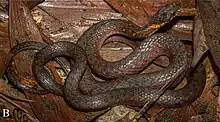| Hebius maximus | |
|---|---|
 | |
| Male from Mt. Laojun in Sichuan | |
| Scientific classification | |
| Domain: | Eukaryota |
| Kingdom: | Animalia |
| Phylum: | Chordata |
| Class: | Reptilia |
| Order: | Squamata |
| Suborder: | Serpentes |
| Family: | Colubridae |
| Genus: | Hebius |
| Species: | H. maximus |
| Binomial name | |
| Hebius maximus (Malnate, 1962) | |
| Synonyms[1][2] | |
| |
Hebius maximus, the western China keelback, is a species of snake of the family Colubridae. The snake is endemic to Southwestern China (Chongqing, Sichuan, northwestern Guizhou).[1][2] Originally described as a subspecies of Amphiesma sauteri (=Hebius sauteri), its validity has been doubted;[1][2] however, it was revalidated by a 2022 study based on morphological and molecular evidence. The evidence even warranted the recognition of Hebius maximus as a full species.[2]
Etymology
The specific name maximus refers to this taxon having the highest count of ventral scales among what at the time were the three subspecies of H. sauteri.[1][2]
Description
Hebius maximus is a small to medium-sized snake, reaching 597 mm (23.5 in) in total length. The tail is relatively long, 25–33% of the total length. Dorsal colouration is reddish-brown or grayish brown, while the ventrum is cream white. An ill-defined dark olive dorsal streak scattered with black spots runs from neck to tail.[2]


Habitat
Hebius maximus occurs in subtropical mountain regions at elevations of about 812–1,200 m (2,664–3,937 ft) above sea level in coniferous forests, large forest clearings, and agricultural areas. It is diurnal, active at dusk. Its prey includes earthworms, slugs, and tadpoles.[2]
References
- 1 2 3 4 Hebius maximus at the Reptarium.cz Reptile Database. Accessed 5 August 2023.
- 1 2 3 4 5 6 7 Li, Mao-Liang; Ren, Jin-Long; Huang, Jun-Jie; Lyu, Zhi-Tong; Qi, Shuo; Jiang, Ke; Wang, Ying-Yong & Li, Jia-Tang (2022). "On the validity of Hebius sauteri maximus (Malnate, 1962) (Squamata, Natricidae), with the redescription of H. maximus comb. nov. and H. sauteri (Boulenger, 1909)". Herpetozoa. 35: 265–282. doi:10.3897/herpetozoa.35.e94920.